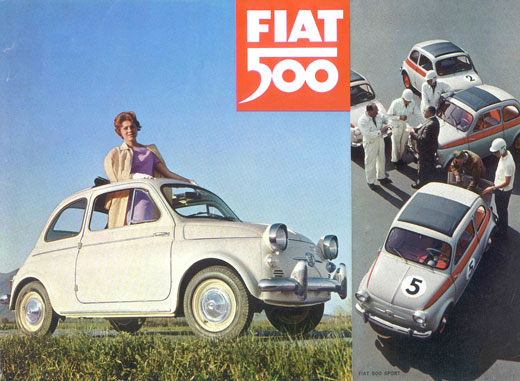
We present a full Fiat 500 brochure, printed for the U.S. market circa 1960. Pages are published in order of appearance in the four sided brochure.
[Read more…] about Just for Fun—Fiat 500 Brochure
The Online Magazine for Italian and French Classic Car Enthusiasts
By pete

We present a full Fiat 500 brochure, printed for the U.S. market circa 1960. Pages are published in order of appearance in the four sided brochure.
[Read more…] about Just for Fun—Fiat 500 Brochure
By pete
Mr. Abarth
By Carl Goodwin
For almost 30 years Gerald Rothman has had the often thankless job of making sure that the rag tag army of Abarth owners in the US and elsewhere have a focal point.
Abarth owners, you see, tend to be as complex, individual, and hard to keep together as their cars. Longtime Abarth enthusiasts include the likes of Judge Parker, a deep fried Southerner who was the lead singer in a very popular country rock band. Mahlon Craft is a bearded lone wolf who lives on a mountain in Connecticut. Dutchman Ed Swart is an ex-Abarth factory driver who married Jim Clark’s girlfriend, while Barry Ward owns and operates a successful chain of travel agencies. Members of the Abarth world can be ultra wealthy businessmen with a team of Abarth sports racers in a multi-car palace or unemployable dreamers with a gasping, rusty Fiat Abarth 850 on a dirt driveway.
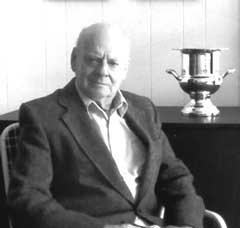
To the average Abarth owner, the idea of a formalized meeting, with officers and notes and agendas and budgets is anathema. An Abarth National Concours will never happen, and they prefer to be each an ‘outlaw’ in his own right. Outwardly, they seem to have little in common. Yet most subscribed to Gerald Rothman’s Abarth Stinger, the lifeblood of the Abarth world and the glue which kept them all in some mode of contact with one another. The Abarth Register, and its organ, The Stinger, are Rothman’s babies…or should we say “were” because “Mister Abarth” is retiring.
Rothman’s Stinger was a chatty, archaic cut and paste job, filled with letters and notes from Abarth owners around the globe, usually addressed to Gerald and Trude, his wife of 60 years . Or they might have been articles reprinted (with permission) from other publications about Abarths, or complex technical articles with scale drawings submitted by the more technical Abarth Register members, or humorous reports of the odd Abarth party or gathering. Rothman himself often wrote a creative article, one memorable piece being called “The Ghost of Carlo Abarth”. Rothman deftly pasted them into the often unnumbered pages of the Xeroxed Stinger and mailed it out to the subscribers in his own time. Think of the Stinger as the exact opposite of the upscale Italian car club publications, yet in many ways is more interesting, vibrant, lively and above all, individualistically human, reflecting the inherent traits of the Editor.
Rothman was unfazed by the latest technologies, unfettered by email with all the accompanying junk and ads, untethered to anything but the US Postal Service. The cut and paste and copy mode worked just fine for him—and his legions of supporters. “If it was good enough for the New York Times, it’s good enough for the Stinger” he once remarked.
The New York Times was once, oh, perhaps 60 years ago, close to home and heart. A young Rothman, having held every position on the school paper at Grover Cleveland High School in Queens, graduated with two awards from the Columbia University School of Journalism, the training ground for NY Times reporters. He applied for a job at the Times, but was turned down — during the Depression, the Times was hiring only men with families to support. As the shadows of war loomed, Rothman enlisted in the Army Air Corps before Pearl Harbor serving, during WWII, as the flight engineer for a B-24 twin-engined bomber. As the war was ending, he worked at Consolidated Aircraft, maker of the PB4Y flying boat. With his journalism credentials, he found a job as a specifications writer for Republic Aviation after the war. As president of the company’s sports car club, Rothman once met Briggs Cunningham while searching for a meeting speaker. He followed up his years at Republic as the editor of the American Newspaper Publishing Association. And he spent the last part of his career as ad writer for the Madison Avenue agency of Watts, Botson, Johnson and Duff.
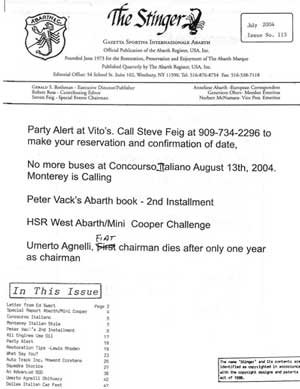
Rothman’s Stinger was mimeograph
but memorable, and more interesting
than the slick magazines that haunt
the newsstands.
Always interested in cars and racing, (particularly the Indianapolis Millers), a chance meeting with Dave Ash (one of the prime movers and shakers of the elite East Coast sportscar set), led to a position who as the research editor for an automobile almanac Ash was interested in publishing. “Ash then went to Scotland for four months to shoot grouse, while I immersed myself into automobile specs.” In doing so, Rothman discovered the tiny Abarth factory, and when the chance to take over the Abarth Register, established by Pete Linksy, he was glad to be of service. “I had journalistic training,” says Rothman, “so it was easy for me to do the newsletter.”
Rothman got a chance to own one of the very rare OTR 1000 Radiales. As we all know from reading Vack’s Abarth Buyer’s Guide, the 1966 OTR was a one liter hemi head engine inserted into the lovely 850 Fiat coupe. Radiale meant radial valves, as differentiated from the DOHC setup. With 85 hp on tap it was good for 105 mph. But not when at a stoplight, which was where the Rothman OTR was sitting when a Chevy Impala nailed it from behind.
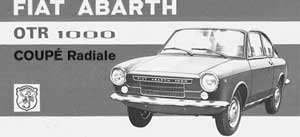
Rothman’s Abarth1000 had it’s misfortunes.
The Abarth lost the contest, and the ambulance took Rothman in one direction and the wrecker took the Abarth in another. The two were never re-united.
A far more enjoyable trip was one for the 1997 Mille Miglia. “Barry Ward made all the arrangements,” Gerry says, “and he was the tour director. About twelve members of the Abarth club went. We went to the Ferrari factory and the Maserati factory, and we followed the route of the Mille Miglia. It was the trip of a lifetime.” Ward recalls those times fondly, and said that “Gerry alone soldiered on, keeping the Abarth flag high on the pole. And I’m sure that he also had to dig into his own pocket to get issues of The Stinger out to subscribers.”
At the news of Gerry’s retirement, Abarth owners sent in their tributes, one of which came from Mahlon Craft: “Gerry’s dedication to producing the Stinger was a welcome breath of fresh air. Somehow, he managed to bring all of us together, with our overblown egos, and ended up with a crowd of people that mostly got along and, when they didn’t, deferred to Gerry. What all of us need to remember was that he was a one-man show in a world where clubs and officers are the usual way. I’d like to say that the ‘Rothman Years’ of my affection for the cars of Carlo Abarth were my best. Perhaps that was just coincidental to the peak of my interest in cars in general. I doubt it though. In some ways, Gerry was like a father to me. Like a spoiled son, I never entirely repaid the favor in kind, but he did make a difference in my life. For that I owe words of thanks that have not found their way into Mr. Webster’s published literary efforts.”
And this, from Greg Paris: “Peter Linsky, who founded the Abarth Register in 1973, was the hare, Gerry Rothman was the tortoise. Gerry finally overtook a tiring Linsky early on, and steadfastly pushed forward until only time and technology finally overtook him,…nearly 30 years later. What a race!”
The Stinger, Rothman’s Stinger, while not a lavish production, was loaded with information that readers really wanted. The mainstream car magazines could learn a lot from Mr. Rothman on the subject of generating reader interest. Letters to Gerry were frequently printed in their entirety. If there was something you would rather not be seen by everyone, it wasn’t a good idea to include it in a letter to Gerry! Recent restorations of member cars, reports and pictures of vintage races, evaluations of motor oils, advertisements from parts suppliers, photos of the charming Annieliese Abarth with various figures in the sport, and letters accompanying checks for dues – from the USA, Italy, Germany, England, Switzerland, and Austria –were all part of this fascinating publication. Feature articles from various publications were reprinted complete and unedited. These have included excerpts from Pete Vack’s Abarth book, a marvelous series on the Cisitalia automobile, an article on OSCAs, and a 10- page Vintage Motorsport feature on the Abarth team, Team Roosevelt. Written by Carl Goodwin and Pete Vack, the piece won a Gold MOTO Award in Walt Haessner’s IAMC competition. With apologies to Walt, the greatest honor for the article came when Gerry announced it on the cover of the Stinger as “The Definitive Team Roosevelt Article.”
Through this great newsletter with its vitality and spirit, Rothman has helped more car enthusiasts than anyone knows to keep these recalcitrant Italian crocks on the road, through a highly useful exchange of parts sources, service expertise, technical information and general encouragement. Of course, Abarth owners put plenty of time and money into the preservation of their machines but, if truth be told, when asked “what keeps your car on the road” they could have answered: Gerald S. Rothman, Executive Director, The Abarth Register, USA.
By pete
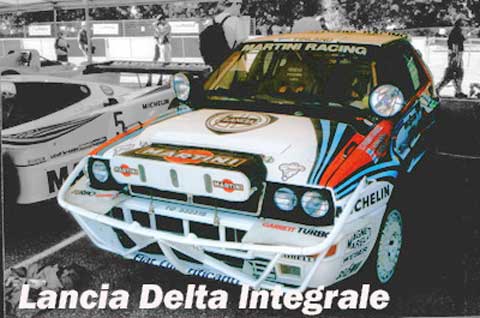
Delta Integrale Evo 1 – seen hear in Safari specification with bull bars. This was the last of the Martini Lancias from 1992
Story and Photos by Hugh Doran
Delta HF 4WD 1986-1987
The demise of Group B left Lancia in a little bit of a pickle. The top flight of rallying from 1987 was going to be Group A and Lancia didn’t have a car for this category as they had been concentrating on the Group B program. However a 1995cc, 258 hp turbocharged Delta was fitted with four wheel drive, painted in the now familiar colors of Martini and sent along to the Monte Carlo rally. Like the S4 before it, it won first time out. Lancia had yet another rally winner on its hands and this time it was with a car that the company had never intended to rally. The Lancia Delta was about to become one of the greatest rally cars in history.
Nine wins were taken in 1987, all of them on the world stage. Lancia’s new car crowned Juha Kankkunen champion, took the manufactures title and took the European Championship in the hands of Dario Cerrate. The HF 4WD was not without its faults – the wheel arches were too small meaning that Lancia had to use smaller wheels than they wanted to. However a rule change for the ‘88 season gave Lancia the chance to address the failing of the HF.
Lancia Delta HF Integrale 1987-1989
The Lancia Delta HF Integrale entered service in the same way that its predecessors had–by winning. Lancia were only beaten once in 1988 – not bad for a new car. In fact they went 12 months and 12 rallies with out losing. Miki Biasion was crowned World Rally Champion, becoming the first Italian to obtain that title. The main difference between the Integrale and the HF to the naked eye was the extended wheel arches, and extra vents were cut into the hood. Under the skin there was a larger intercooler and larger Garret T3 turbocharger. Officially the power output was 280bhp, unofficially power output was reckoned to be closer to 400bhp. The FIA had imposed a rule that restricted power output, but never got around to policing it!. Thus the actual power output of the cars is only really known by those that built them.
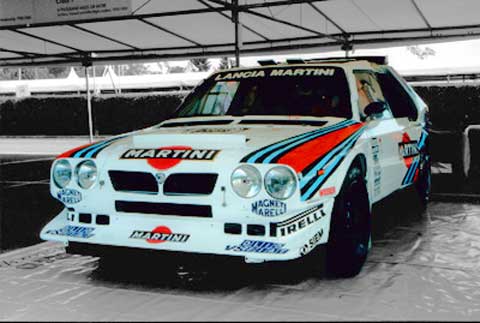
An earlier Delta S4 quietly sits in the Goodwood paddock.
Lancia Delta HF Integrale 16V 1989-1991
Towards the back end of 1989 Lancia rolled out the 16v version of the Integrale on the rally of San Remo. Naturally it won first time out, this time in the hands of Miki Biasion. However the Lancia management must have had a mild panic when Didier Auriol rolled out of the event.. This time however there was something different about the Lancia’s. Yes they were still in Martini livery, but instead of being white the cars were red. This is the only time the factory cars appeared in Italian racing red.
Extra torque was the main reason given for the introduction of the 16v head. but in fact that the Japanese manufacturers were beginning to catch the Delta’s and could smell blood. The Lancia lost the driver’s world championship to Toyota-equipped Carlos Sainz, although Lancia were still took the manufactures title back to Turin, and Robert Droogmans took the European title. Things may have been different if Lancia had sorted the break problems that the car suffered on tarmac earlier. This is reinforced by the then semi-works Jolly Club team who believed the new Delta to be half a second per kilometer quicker than the old car.
The HF Integrale 16v wasn’t all doom and gloom as this was the car that dominated the 1991 world championship, taking giving Lancia yet another manufactures title. Juha Kankkunen became champion for the third time on the world stage and Piero Liatti was crowned European champion. Let’s not forget that when all was said and done the Delta HF Integrale 16V took 13 world rally wins in a career lasting two and a half years – this made the car the hardest working Integrale of them all.
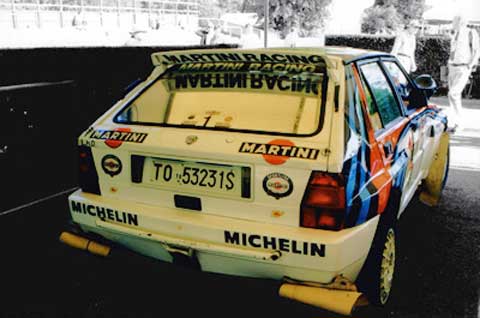
The roof spoiler identifies this as a Delta HF Integrale Evo1 – this was Juha Kannkkenen’s car from the 1992 Safari rally.
Lancia Delta HF Integrale EVO 1 1991-1992
As 1992 came along so did what was to become the last incarnation of the Delta Integrale. Officially this was still known as the Delta Integrale HF, however the majority of people refer to it as either the Integrale Evolution or the Super Delta. The latter being a rather silly name in this author’s eyes. For the record the Evolution, or “Evo” tag was far more appropriate as Lancia had tweaked here and there. Delta HF Integrale Evo1 and Evo2 were the last great rally Lancias. The most obvious difference was the roof spoiler which is the easiest was to identify these latter cars.
1992 proved to be quite a vintage year for Lancia. Eight wins were taken, including the cars debut rally thanks to Didier Auriol, but little did we know at the time that Andrea Aghini’s win in Sanremo was to be Lancia’s last in the world rally championship. At the end of the year the team packed the Martini livered cars away, returned to Turin and put their feet up. The dream was over.
It wasn’t the end for the Delta through. Carlos Sainz rallied one in 1993 – without any really success. Second place in Greece was the best that could be done, espite the fact that Lamborghini were now on board tweaking the engines. The trouble was that the Intergrale was past its “sell by” date.
Today rallying is very different to how it was in the 1980’s and 1990’s – not all the changes have been for the better, but that is another story. The Delta Integrale is now a legend, where as the 037 and Delta S4 are, sadly, largely forgotten. One thing that still remains is peoples fondness for the Martini Lancia’s – oh happy days!
To purchase a copy of “Lancia Delta HF Integrale”, the most comprehensve book ever written on this world champion, click here:
Buy NOW!
Read VeloceToday Book Review:
Lancia Delta HF Integrale
By pete
There was no edition of VeloceToday last week as we were having our yearly computer check up and updates. We apologize for any inconvenience. The answer to our mystery engine can be found below–and it may surprise you. Thanks for all the comments!
This week, we feature the Birdcage Maserati. Be sure to check our Maserati books in the VeloceToday bookstore–Dalton Watson is offering a savings of $65 if you order both of the excellent books on the Maserati Birdcages. Note too, Karl Ludvigsen’s books on “Italian Racing Red” and “Red Hot Rivals”. All would make great holiday gifts.
Women with Alfa Romeos are always “of Interest”, and this week we’d like your help in identifying the woman in the photo below. Mid 1920s, probably French, perhaps Italian, a young woman poses here with her Alfa 3-liter RL Super Sport for a 1920s Bois de Bologne event. May it be someone’s dearly departed Grandmother. Photo is part of the collection of author Jean-Francois Bouzanquet, in whose book “Femmes Pilotes de Courses Auto 1888-1970” (English title, Fast Ladies) the photo appears. Let us know if you know.
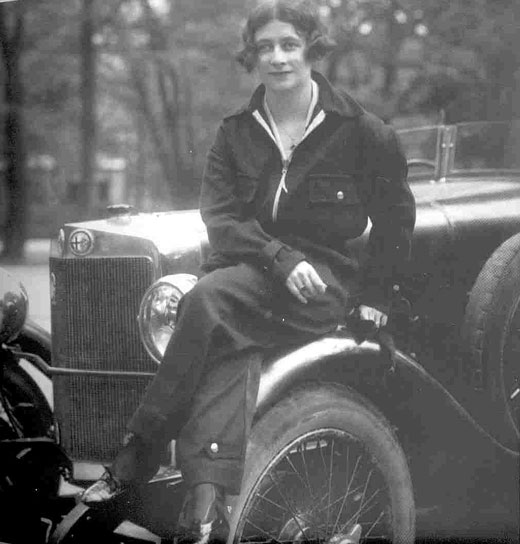
By pete
Last week we received the latest edition of Classic and Sportscar magazine, a bit late but always nice to see our VeloceToday ad in the back pages. When I picked it up, an insert fell out–and when I looked down on the floor to see what it was, a familiar set of eyes peered back at me.
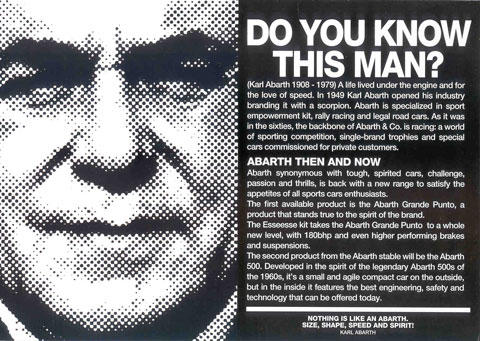
Did I know this man? Maybe it’s a Wanted by Scotland Yard poster, or someone is lost, like the kids on the milk cartons. But as it came into focus I could tell it was Karl Abarth.
[Read more…] about Advertising Abarth
By Brandy
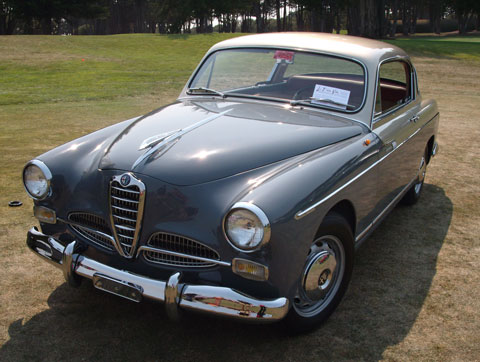
By Brandes Elitch
One of the most striking cars at the first edition of La Dolce Vita at the Monterey Historics was a 1957 Alfa 1900 Primavera coupe with a Boano body. This car is so rare that I have never even seen a picture of one. [Read more…] about 1957 Alfa 1900 Boano Primavera
By Mike
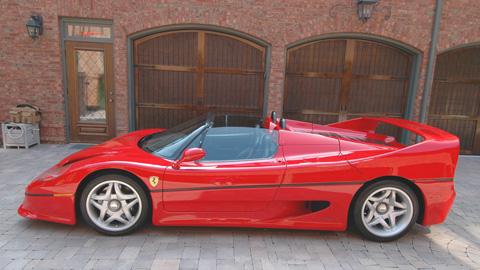
Ferrari F50
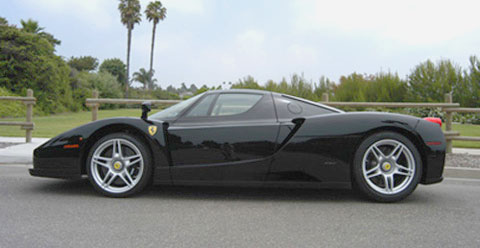
Ferrari Enzo
Michael Sheehan looks at the Ferrari Supercars
Part 2 focuses on the V12 F50 and Enzo
All photos by Michael Sheehan unless otherwise noted.
Read Part 1
F50; back to a V-12
“Fifty years of racing, fifty years of winning, fifty years of hard work.” With these words Luca Montezemolo, head of Ferrari S.P.A., introduced the F50 at the Auto Museum in Geneva, Switzerland, on March 6, 1995 in conjunction with the 63rd annual international Automobile Show. [Read more…] about Ferrari by Sheehan
By Pat
Interview with Jon Shirley, owner of the Nuvolari P3.
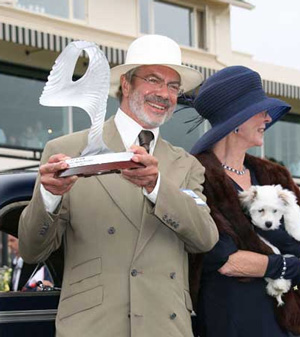
Jon and Mary Shirley at Pebble Beach 2008.
Photo by Hugues Vanhoolandt.
Jon Shirley developed an interest in cars when he was nine, driving an old truck on a farm. Later when in college, he attended races at Watkins Glen, Thompson and Lime Rock. Naturally he developed an interest in sports cars and racing–one that would last until the present time. [Read more…] about Jon Shirley on Kids and the Nuvolari P3
By pete
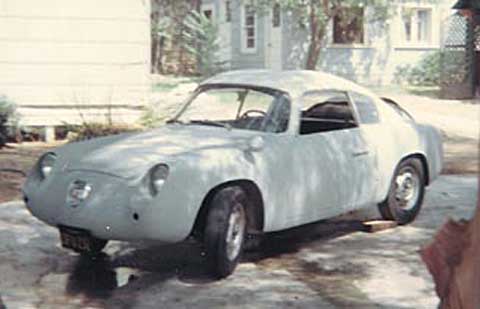
A Zagato in the closet
Bill Henry called me at Automech. We met a couple of weeks earlier during a Riverside SCCA weekend. He had stopped by the shop and admired my bright turquoise Mini, with the ivory stripe to match its wheels. Now he was proposing a trade. An even trade for pinks. [Read more…] about A Car Life by Larry Crane
By pete
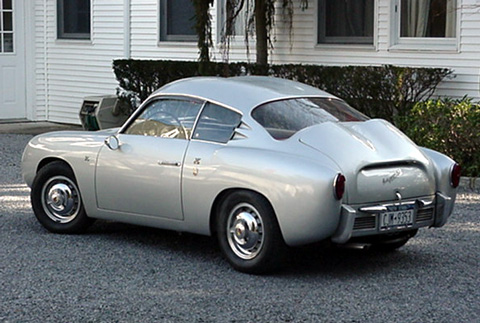
Today the subject of this article resides in a collection in New York.
The story of a particular Zagato in America
Story and Photos by Pete Vack unless otherwise noted
The name sounded odd–Fiat Derivazione Abarth 750 GT Zagato–and did not easily roll off American tongues. But once seen, the car was not easily forgotten, while the long, strange name was quickly replaced by the nickname “Double Bubble”. Not only did it refer to the unique top, but Dubble Bubble is also the name of the original chewing bubble gum, which was very popular at the time, that being 1958-59.
[Read more…] about A Zagato in America
By Mike
Michael Sheehan looks at the Ferrari Supercars-Part I
All photos courtesy Michael Sheehan unless othewise noted.
Below, the evolution of a species.
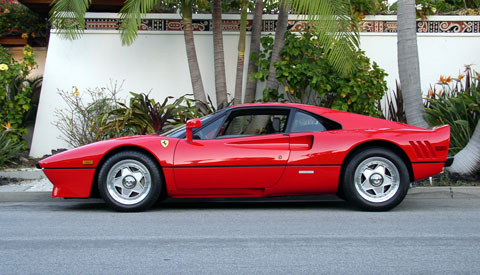
288 GTO s/n 54231
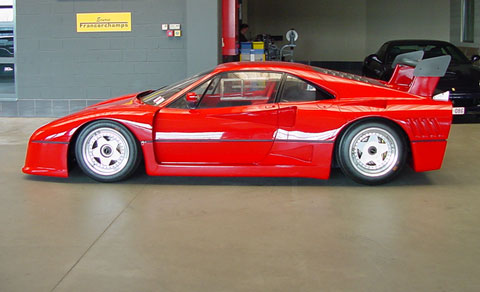
288 Evo s/n 79888
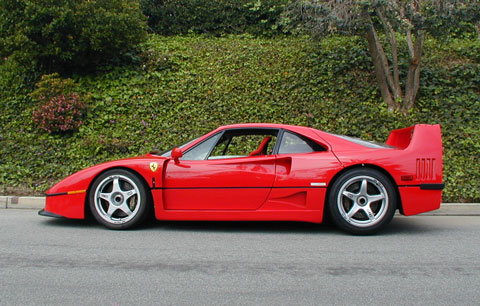
F40 s/n 90568
Before they were called Supercars
Through the 1950s and up to the mid-1960s Ferrari built a very limited series of luxurious, big-engined, custom bodied supercars, starting with a short run of only six 342 Americas,the 375 America, followed by the 410 Superamerica, the 400 Superamerica, the 500 Superfast and ending with the 365 California. [Read more…] about Ferrari by Sheehan
By Gerelli
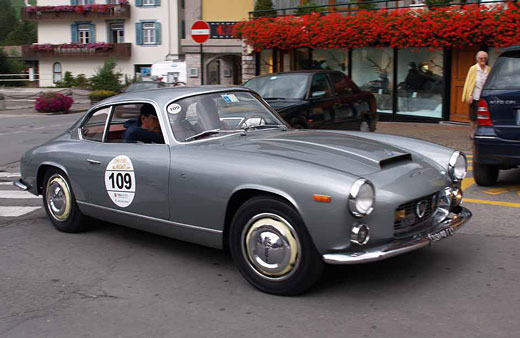
1962 Lancia Flamina Sport Zagato. Federico Alzona
A wonderful variety of Lancias parade for Alessandro Gerelli at this year’s Coppa d’oro delle Dolomiti.
[Read more…] about Lancias at Cortina 2009